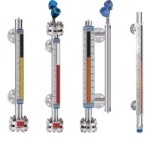 |
Wireless Process Instrument
Courtesy Yokogawa |
The performance of every process is critical to something or someone. Keeping a process operating within specification requires measurement, and it requires some element of control. The devices we use to measure process variables, while necessary and critical in their own right, are also a possible source of failure for the process itself. Lose the output of your process instrumentation and you can incur substantial consequences ranging from minor to near catastrophic.
Just as your PLC or other master control system emulates decision patterns regarding the process, the measurement instrumentation functions as the sensory input array to that decision making device. Careful consideration when designing the instrumentation layout, as well as reviewing these five common sense recommendations will help you avoid instrument and process downtime.
Process generated extremes can make your device fail.
Search and plan for potential vibration, shock, temperature, pressure, or other excursions from the normal operating range that might result from normal or unexpected operation of the process equipment. Develop knowledge about what the possible process conditions might be, given the capabilities of the installed process machinery. Consult with instrument vendors about protective devices that can be installed to provide additional layers of protection for valuable instruments. Often, the protective devices are simple and relatively inexpensive.
Don't forget about the weather.
Certainly, if you have any part of the process installed outdoors, you need to be familiar with the range of possible weather conditions. Weather data is available for almost anywhere in the world, certainly in the developed world. Find out what the most extreme conditions have been at the installation site....ever. Planning and designing for improbable conditions, even adding a little headroom, can keep your process up when others may be down.
Keep in mind, also, that outdoor conditions can impact indoor conditions in buildings without climate control systems that maintain a steady state. This can be especially important when considering moisture content of the indoor air and potential for condensate to accumulate on instrument housings and electrical components. Extreme conditions of condensing atmospheric moisture can produce dripping water.
Know the security exposure of your devices.
With the prevalence of networked devices, consideration of who might commit acts of malice against the process or its stakeholders, and how they might go about it, should be an element of all project designs. A real or virtual intruder's ability to impact process operation through its measuring devices should be well understood. With that understanding, barriers can be put in place to detect or prevent any occurrences.
Physical contact hazards
Strike a balance between convenience and safety for measurement instrumentation. Access for calibration, maintenance, or observation are needed, but avoiding placement of devices in areas of human traffic can deliver good returns by reducing the probability of damage to the instruments. Everybody is trained, everybody is careful, but uncontrolled carts, dropped tools and boxes, and a host of other unexpected mishaps do happen from time to time, with the power to inject disorder into your world. Consider guards and physical barriers as additional layers of insurance.
Know moisture.
Electronics must be protected from harmful effects of moisture. Where there is air, there is usually moisture. Certain conditions related to weather or process operation may result in moisture laden air that can enter device enclosures. Guarding against the formation of condensate on electronics, and providing for the automatic discharge of any accumulated liquid is essential to avoiding failure. Many instrument enclosures are provided with a means to discharge moisture. Make sure installation instructions are followed and alterations are not made that inadvertently disable these functions.
Developing a thoughtful installation plan, along with reasonable maintenance, will result in an industrial process that is hardened against a long list of potential malfunctions. Discuss your application concerns with your
instrument sales engineer. Their exposure to many different installations and applications, combined with your knowledge of the process and local conditions, will produce a positive outcome.






